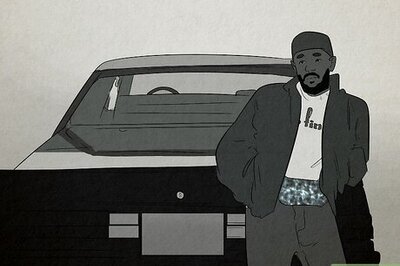
views
‘We are from Jamnagar,’ said the head of the family of four who had come toiling up my steps on a cold but sunny Diwali morning. ‘Our daughter has one of your books in school, and her teacher says you are the writer from Jamnagar! She would like to pay her respects.’
A smiling girl of about ten stepped forward and shook my hand. ‘When were you in Jamnagar?’ she asked.
‘Eighty years ago,’ I told her. ‘The first six years of my life were spent there. That’s where I learnt to read and write—in the little palace school.’
‘That’s why you’re the writer from Jamnagar,’ she said simply. ‘And when will you come again?’
‘Probably in my next life,’ I said. ‘It must be a very big city now; I wouldn’t find the places I remember.’
‘You’ll find them,’ she said.
Jamnagar! How quaint to be called ‘the writer from Jamnagar’. I must say that it gave me a good feeling. I’ve grown used to being called ‘the writer from Mussoorie’, although there are a number of other writers who can lay their claim to that title. Jamnagar must have had other, mostly Gujarati, writers, to boast of, but in the years from 1934 to 1940, when I was an infant and then a troublesome small boy, the only ‘writer’ we knew of was Mrs Ghosh, the secretary to Jam Sahib, the state’s ruler. Mrs Ghosh was always to be found before Jam Sahib’s desk, taking dictation and writing letters to potentates all over the world.
Jamnagar was a small state with a small port and a very rich maharaja, or Jam Sahib as he was called. He owned dozens of Rolls-Royces and an equal number of chauffeurs. He was also a very generous man who, when World War II broke out, gave refuge to several thousand Polish families fleeing from Hitler’s storm troopers.
Jamnagar was also the state where Indian cricket was born. So the earlier ruler, Ranjit Sinhji, played for England; a magnificent batsman; so did his nephew, Duleep Sinhji, a master of the glide to leg. And it was on the Jamnagar ground that the great all-rounder Vinoo Mankad won his spurs, going on to make a double century at Lord’s, a few years later.
I have memories of the cricket ground in Jamnagar, although not of the cricket. Sitting with my parents in the VIP section, my attention was given over to the steady rotation of trays of sweets—gulab jamuns, rasgullas, jalebis, barfis, savouries of every kind—that circulated among the spectators. How could a small boy concentrate on the cricket when all these delicacies kept finding their way into his greedy little hands. No wonder, then, that when I did grow up to play a little cricket, I was inevitably made the twelfth man, carrying out the drinks and refreshments for the rest of the team.
So, what were we doing in Jamnagar just before the war and Indian Independence?
My father was a travelling teacher who, rather than teach in a school, preferred to take up tutorial jobs in the Indian states, of which there were many in those days. He had taught young princes in Bharatpur and Alwar, and at the time of my birth he had moved to the Kathiawar states, doing stints in Jatpur and Pithodia before starting a small palace school in Jamnagar, where we were to live till 1941.
It was a small school, occupying one large room in an old palace, and most of the pupils were girls. I remember them clearly (and still have their photographs): Mamta, who was the oldest, about twelve, and quite beautiful; Janak, who was chubby and jolly, always pinching my cheeks; Ratna, serious, thoughtful; and ‘Hathi’, my age, very sweet and mischievous. These were all princesses. There was also the little prince, the heir to the throne, but I did not see much of him, he was being groomed for a public school, I think. But I do have a photograph of the two of us romping in the sea of Balachadi beach.
The old palace had a turret going up two or three floors, and at the top was a small glassed-in room, each pane of glass a different colour. This was my favourite place. I loved looking through those coloured panes, at the lake or the main palace or the gardens, tinted pink or blue or green or purple or orange. Many years later, I was to write a story centred around this room. It was called ‘The Room of Many Colours’. In the story there was an eccentric Rani who gave me sweets, but she was a figment of my imagination. Many of my stories are like that. I start by describing a known place, or persons, and then my imagination takes over and the incidents run away from me.
But this is a memoir, so I must tell the truth.
We had a good cook, but he was not the one who cooked for Jim Corbett while the great hunter was felling man-eating tigers. Our cook made excellent fish cutlets and guava jam, and he ran away with the ayah; but those were the only accomplishments that I can recall.
I should have said that my ayah ran away with the cook, for she was the stronger personality. She reigned supreme in the house. My father never punished me. My mother tried to, but I was too elusive. But there was no escaping ayah’s large hands if she was on the warpath. She wouldn’t hesitate to bend me over her knee and smack me hard on the bottom. She was fond of me, and in a way, it was a sign of ownership, for she knew no one else would go so far as to give me a good spanking.
I was a funny child. I loved sweeping the veranda steps. I had watched the ayah doing this occasionally, so I borrowed her broom and swept the steps and the veranda whenever they grew muddy or covered with fallen leaves. It gave me a passion for tidiness. I don’t sweep verandas any more (just in case you want to hire me for the job), but I like a neat house and my books and papers in the right place. Like Hercule Poirot, if a picture on the wall isn’t hanging properly, I’ll straighten it.
But I hated haircuts. I dreaded the monthly visits of the unfortunate man who had to cut my hair. I would go into hiding, and when found, would have to be rolled up in a bedsheet and taken, kicking and screaming, to a high chair where my golden locks would be shorn off. On one occasion my mother lost patience with me and let me go halfway through the haircut. For weeks, I went about looking like a cartoon-strip character, long hair on one side of my head and short hair on the other. Today, it would be considered the height of fashion!
Read all the Latest News, Breaking News and Coronavirus News here. Follow us on Facebook, Twitter and Telegram.




















Comments
0 comment